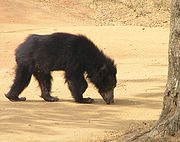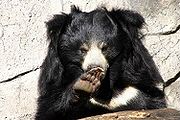|
Tami Nadu - Wildlife of Tamil Nadu - Reproduction Of Sloth Bear
Reproduction Of Sloth Bear
Reproduction
The breeding season for sloth bears varies according to location: in India, they mate in April, May and June, and give birth in December and early January, while in Sri Lanka, it can be done all year. Sows gestate for 210 days, and typically give birth in caves or in shelters under boulders. Litters usually consist of 1-2 cubs, rarely 3.[ Cubs are born blind, and open their eyes after four weeks.Sloth bear cubs develop fast compared to most other bear species: they will start walking a month after birth, become independant at 24-36 months, and become sexually mature at the age of 3 years. Young cubs will ride on their mother's back when she walks, runs or climbs trees until they reach a third of her size. Individual riding positions are maintained by cubs through fighting. Intervals between litters can last 2-3 years.
Sloth Bear Sub-species
Sub-Species Name
|
Distribution |
Description |
|
Sri Lankan sloth bear (Melursus ursinus inornatus) Pucheran, 1855
 |
Sri Lanka |
Sri Lankan sloth bears have much shorter body hair, making them appear less shaggy. They are also smaller in dimensions, even in the teeth. They sometimes lack the characteristic white chest mark.[7] At the turn of the century, sloth bears were found throughout Sri Lanka, but reduced in number after the turn of the century, due to wide scale conversion of upland forests into tea and coffee plantations. They are now restricted to the northen and eastern lowlands. |
Common sloth bear (Melursus ursinus ursinus) (Shaw, 1791

|
India, Nepal, Bhutan and Bangladesh |
In India, their distribution is patchy, and mostly occur in areas of forest cover. They are absent in the high mountains of Himachal Pradesh and Jammu and Kashmir, the northwestern deserts of Rajasthan, and a broad non-forested swath in the south. Sloth bears are the most widespread bear species in India, being found in the Siwaliks, low hills bordering the outer range of the Himalayas from Punjab to Arunachal Pradesh, though they are no longer found as far west as Punjab. They are isolated from the sloth bear populations of Nepal, due to the conection being broken by agricultural lands. Sloth bears in Nepal are mainly restricted to the Terai, the southern strip of lowland forest and grasslands bordering India. A few isolated populations may still occur in the Chittagong and Sylhet regions of eastern Bangladesh.
|
Relationships with humans
Attacks on humans
According to Robert Armitage Sterndale, in his Mammalia of India:
[The sloth bear] is also more inclined to attack man unprovoked than almost any other animal, and casualties inflicted by it are unfortunately very common, the victim being often terribly disfigured even if not killed, as the bear strikes at the head and face. Blanford was inclined to consider bears more dangerous than tigers…
—Mammalia of India p.62
Captain Williamson in his Oriental Field Sports wrote of how sloth bears rarely killed their human victims outright, but would suck and chew on their limbs till they were reduced to bloody pulps. One specimen, known as the Sloth bear of Mysore, was singlehandedly responsible for the deaths of 12 people and the mutilation of 2 dozen others before being shot by Kenneth Anderson. Although sloth bears have attacked humans, they rarely become man-eaters. Dunbar-Brander's Wild Animals of Central India mentions a case in which a sow with two cubs began a six week reign of terror in Chanda, a district of the Central Provinces, during which more than one of their victims had been eaten, while the sloth bear of Mysore partially ate at least three of its victims. R.G. Burton deduced from comparing statistics that sloth bears killed more people than Asian black bears, and Theodore Roosevelt considered them to be more dangerous than American black bears. In Madhya Pradesh, sloth bear attacks accounted for the deaths of 48 people and the injuring of 686 others between the years 1989 and 1994, probably due in part to the density of population and competition for food sources. A total of 137 attacks (resulting in 11 deaths) occurred between April 1998 and December 2000 in the North Bilaspur Forest Division of Chhattisgarh. The majority of attacks were perpetrated by single bears, and occurred in kitchen gardens, crop fields, and in adjoining forests during the monsoon season. A Mr. Watts Jones wrote a first hand account of how it feels to be attacked by a sloth bear, recalling when he failed to score a direct hit against a bear he had targetted:
I do not know exactly what happened next, neither does my hunter who was with me ; but I believe, from the marks in the snow, that in his rush the bear knocked me over backwards in fact, knocked me three or four feet away. When next I remember anything, the bear's weight was on me, and he was biting my leg. He bit two or three times. I felt the flesh crush, but I felt no pain at all. It was rather like having a tooth out with gas. I felt no particular terror, though I thought the bear had got me; but in a hazy sort of way I wondered when he would kill me, and thought what a fool I was to get killed by a stupid beast like a bear. The shikari then very pluckily came up and fired a shot into the bear, and he left me. I felt the weight lift off me, and got up. I did not think I was much hurt. . . . The main wound was a flap of flesh torn out of the inside of my left thigh and left hanging. It was fairly deep, and I could see all the muscles working underneath when I lifted it up to clean the wound."
—Living Animals of the World p.119
It is likely that sloth bears view humans as predators, as their reactions to them (roaring, followed by retreat or charging) are similair to those evoked in the presence of tigers and leopards.
Hunting and products
Sloth bear have been called an indifferent trophy. In some ways this may be true, for the body is covered with a gray hair, eight or nine inches long, instead of fur. Most hides are mounted as rugs. This gives the animal his poor rating. But when only the head is mounted, it makes a handsome and interesting trophy.
—Heart of a Hunter: Big Game Hunting p.146
One method of hunting sloth bears involved the use of beaters, in which case, a hunter waiting on a post could either shoot the approaching bear through the shoulder or on the white chest mark if it was moving directly to him. Sloth bears are very resistant to body shots, and can charge hunters if wounded, though a man of steady nerves could score a direct hit from within a few paces of a charging bear. Sloth bears were easy to track during the wet season, as their clear footprints could be followed straight to their lairs. The majority of sloth bears killed in forests were due to chance encounters with them during hunts for other game. In hilly or mountainous regions, two methods were used to hunt sloth bears there: one was to lie in wait above the bear's lair at dawn and wait for the bear to return from its nocturnal foraging. Another was to rouse them at daytime by firing flares into the cave to draw them out. Sloth bears were also occasionally speared on horseback. In Sri Lanka, the baculum of a sloth bear was once used as a charm against barrenness.
|
